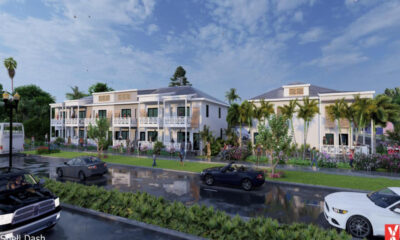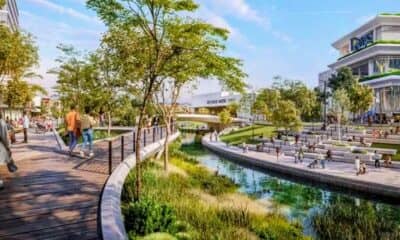Thrive
City leaders from across the country talk growth at Development Summit

In light of the explosive development sweeping the region, the Urban Land Institute (ULI) Tampa Bay and the St. Petersburg Downtown Partnership hosted the first-ever St. Pete Development Summit to shed light on how other cities have managed growth.
Held Tuesday at the James Museum of Western and Wildlife Art, the summit sought to show how decisions can impact an area’s quality of life and alter a sense of place, equity, values and culture. Several business, along with political and community leaders from throughout the region attended the summit, hoping to glean helpful information from outside their communities.
Leroy Moore, vice chair for ULI Tampa Bay, said his organization is the largest and oldest network of cross-sectional disciplinary real estate and land-use experts in the world, with over 45,000 members worldwide and 600 throughout the bay area.
“As St. Pete and the Tampa Bay region has experienced astounding growth, we are wise to look and learn from cities like Austin, Baltimore, Philadelphia and Boulder,” said Moore.
During his opening remarks, Mayor Ken Welch said the summit provided the opportunity to learn from the panel’s experiences in their communities and take away lessons that will better inform St. Petersburg’s decision-making process. He said the city would also draw knowledge from a remarkable network of entrepreneurs, visionaries, educators, business and cultural leaders, all of whom were well-represented at the summit.
Representing Boulder, Colorado, was Cris Jones, director of community vitality for that metropolitan area, who explained how the affluent city of just over 100,000 – with about a third comprised of college students – has instituted “smart growth” strategies since the late 1800s.
“The community said it wants to project a positive identity as to not become an anonymous suburb,” said Jones. “I think what we’ve proven is that part of the plan has panned out – Boulder is known throughout the country and the world.”
Jones said the city encourages development, so long as it does not bring in the “wrong kind of people,” cause parking and traffic problems or obstruct views. He said the city has adopted several affordable housing initiatives and now focuses on ensuring affordable commercial properties for small businesses.
One citizen-led initiative is tying the occupancy of a residence to its number of bedrooms. However, Jones said that initiative has led to several unintended consequences.
Cheryl Washington and Karen Johnson of East Baltimore Development, Inc (EBDI), said their organization was founded after a loss of jobs, riots and an exodus of middle-class families on the east side of Baltimore. By 2000, 70% of structures in the neighborhood were vacant, and the crime, unemployment and poverty rates were soaring.
“The newspaper used to write about it (the neighborhood) and called it Zombieland,” said Washington.
EBDI changed the narrative by adopting guiding principles to restore East Baltimore, beginning with preserving and celebrating the area’s history and community engagement. Washington said EBDI includes residents on its board of directors and throughout its committees. EBDI also conducted a study to identify career pathways stemming from its project area, and philanthropic groups then funded training programs to prepare residents for those jobs.
Washington said EBDI classified a third of the housing in the development area as affordable. Officials also created a subsidy to help those forced to relocate return to the city.
Matt Rader, president of the Pennsylvania Horticulture Society, explained that a well-gardened public realm is a critical urban element that creates affordable and equitable advances in health and well-being.
Rader said that cleaning vacant lots, planting trees, supporting community gardens and creating gardens in public spaces had several positive impacts on Philadelphia. He said these community interventions reduced violent crime, decreased stress and depression, created business opportunities and jobs and increased property values.
“Everything we do is really rooted in the community,” said Rader. “What the East Baltimore folks were talking about is us – we do services in support of community development corporations and community volunteer groups that actually deploy the work on the ground.”
Rader said his organization now supports over 160 community gardens throughout Philadelphia. A land trust partner provides the land, the Horticulture Society supplies the materials, and in turn, the gardens provide food and strengthen community bonds.
Molly Alexander, executive director for the Downtown Austin Alliance Foundation, said Austin has doubled in population every 20 years since the city was founded. As Austin approaches a million residents, Alexander said the focus has shifted to maintaining the city’s “soul.”
Alexander said in 2016, her organization changed its focus to four pillars: a thriving center, welcoming places, growing neighborhoods and establishing mobility.
“A thriving center did not just mean traditional economic development, it said, ‘let’s make it affordable,’” said Alexander. “I’m not sure you can live downtown always … but I want to be able to get an affordable meal. I want to be able to get transportation to that place. I want to be able to work in that place. I want it to be part of who I am – I want to benefit from it.”
Alexander said residents of Austin had to intentionally ask themselves who they are, what they cared about and how they could uplift each other.
She said residents and officials in St. Petersburg need to identify what is most important to them and then intentionally and individually make choices to support those causes. Alexander said St. Pete would continue to grow, calling it an amazing city that connects people. She said the vibe people feel in St. Pete will continue luring new residents and businesses.
“It’s OK,” said Alexander. “But remember where you put your time and your money – you want it to be where it makes you happy. Makes your city happy, makes other people happy, it’s equitable, it’s fair and it is who you are as a city.”







